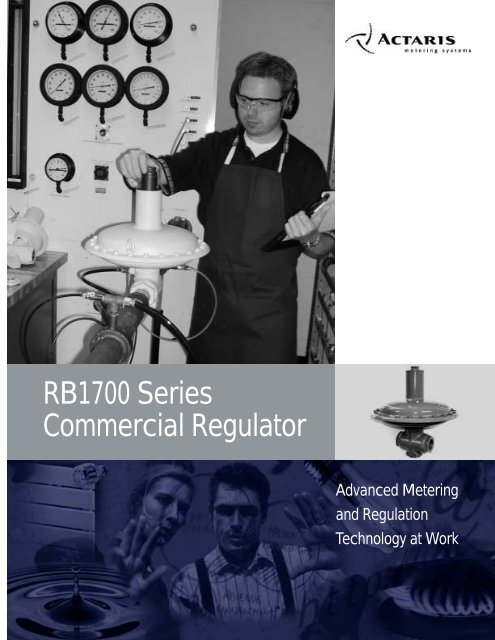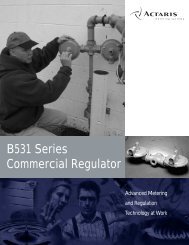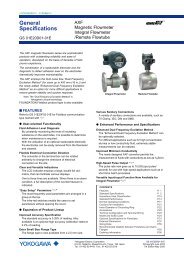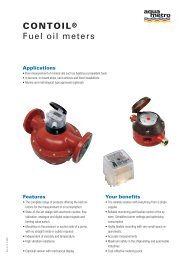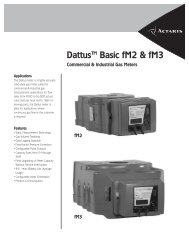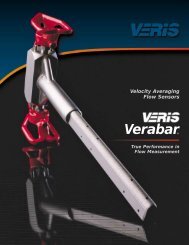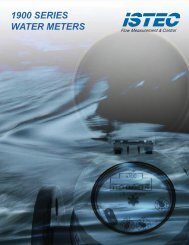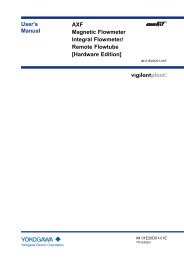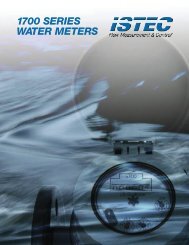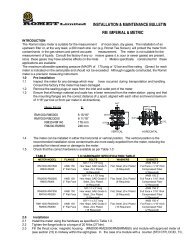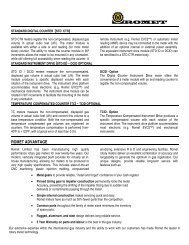Model RB1700 Commercial Regulator - Istec Corp.
Model RB1700 Commercial Regulator - Istec Corp.
Model RB1700 Commercial Regulator - Istec Corp.
Create successful ePaper yourself
Turn your PDF publications into a flip-book with our unique Google optimized e-Paper software.
<strong>RB1700</strong> Series<strong>Commercial</strong> <strong>Regulator</strong>Advanced Meteringand RegulationTechnology at Work
<strong>Model</strong> DesignationsPressure <strong>Regulator</strong>RB 1700Benefits-Accurate regulation-Fast response-Easy maintenance-Compact size- Wide Range of outlet pressure-Horizontal or Vertical mountingDescriptionThe RB 1700 is a direct-acting,spring-loaded regulatorThe balanced valve designensures a constant outletpressure when the upstreampressure varies. This eliminatesthe need for orifice size changesarising from the different inletpressure ranges.ApplicationsThe RB 1700 regulator isdesigned for commercialapplications: industrial boilersand furnaces, appliance pressureregulation, secondary regulationof plant distribution piping, andallinstallations with continuousconsumption and rapid flow ratevariations, such as burners,industrial ovens, boilers, etc.Suitable for installation incabinets, as a space savingregulator.R X X 1 7 X X OptionsBEBalanced Valve DesignExternal Registration1 Low pressure (7” w.c. – 3.0 psig):2 Medium pressure (1.7 - 13.0 psig)3 High pressure (7.3 – 36.0 psig)0 No safety devices1-1/2” 1-1/2” body - Orifice Size: 1-1/8”Example: RBE1720 with 1-1/2” body is a 1700 series regulator with balanced valve, an External Control line, and 1-1/2” NPT Valve body connectionPrinciple of Operation (See Operating Schematic below)The <strong>RB1700</strong> employs a direct-acting spring-loadeddesign that allows for extremely fast response as wellas reliable closure during no-load conditions.Increasing Load Condition:As downstream demand increases, the downstreampressure begins to fall, which, in turn causes thesensing line pressure and the pressure under the maindiaphragm to decrease. When the pressure under themain diaphragm drops, the spring force is able to movethe diaphragm downward and, thus, the main valvefurther open to meet the increased demand.Decreasing Load Condition:As the downsteam load is decreased, the pressurebegins to rise in the sensing line and under the maindiaphragm. The pressure under the main diaphragmovercomes the spring force and moves the diaphragmupward. This allows the valve to move closer to the<strong>RB1700</strong> Operating Schematicorifice face and decrease the flow through the valveuntil it matches the downsteam demand.No Load (lock-up) Condition:As the downsteam load is shut-off, the pressure beginsto rise in the sensing line and under the maindiaphragm. The pressure under the main diaphragmovercomes the spring force and moves the diaphragmupward. The pressure rises enough to push the rubbervalve seat again the stainless steel orifice, forming apositive seal during no-load conditions.Outlet PressureAdjustment ScrewAdjustment SpringDownstream sensingchamberBalancingDiaphragmOrifice2Valve SeatInlet PressureOutlet Pressure
SpecificationsConstructionValve bodyDuctile IronOrificeStainless SteelValve seatBrass with vulcanized Buna-NValve stemStainless SteelValve stem bushingsNylon“O”-ring SealsBuna-N Nitrile RubberDiaphragmBuna-N and nylon reinforcing fabricAdjustment screwBrassDiaphragm caseStamped SteelShipping Weight1 <strong>Regulator</strong> per boxWeight per box: 35 lbs.Correction factors for non-natural gas applicationsThe <strong>RB1700</strong> may be used to control gases other than natural gas. Todetermine the capacity of the <strong>RB1700</strong> for gases other than natural gas, it willbe necessary to multiply the values within the capacity tables by a correctionfactor. The table below lists the correction factors for some of the morecommon gases:Gas Type Specific Gravity Correction Factor (CF)Air 1.0 0.77Butane 2.01 0.55Carbon dioxide (Dry) 1.52 0.63Carbon monoxide (Dry) 0.97 0.79Natural gas 0.60 1.00Nitrogen 0.97 0.79Propane 1.53 0.63Propane-air-mix 1.20 0.71To calculate the correction factor for gases not listed on the table above, itwill be necessary to know the specific gravity of the gas and use it in theformula listed below:Correction Factor (CF) =Spring Range Data<strong>Model</strong> NumberPart Number Spring ColorRB1710 RB1720 RB1730(14” diaphargm) (8” diaphragm) (8” diaphragm)20567075 Yellow 6.8 – 9.2” w.c. --- ---20567076 Red 8.4 – 12.8” w.c. --- ---20567662 White 10.9 – 21.2” w.c. --- ---20567663 Purple Pilac 0.3 – 1.4 psig 1.9 – 5.3 psig ---20567664 Orange 1.2 – 3.0 psig 2.9 – 8.7 psig ---20567665 Brown --- 4.4 – 9.4 psig 7.3 – 14.5 psig20567666 Green --- 5.8 – 13.0 psig 8.7 – 19.5 psig20567761 Black --- --- 11.6 – 21.7 psig20567762 Grey --- --- 16.0 – 36.0 psigMaximum Inlet PressureOutlet pressure Range230 psig6.8” w.c. – 36.0 psigTemperature range-20°F to +140°FAcceptable gasesNatural gas, propane, butane,air, nitrogen or any non-corrosive gasMounting PositionHorizontal or verticalPressure RegistrationExternal (control line required - 1/4” NPT)Vent Connection1/4” NPTValve Body Sizes1-1/2” NPTOrifice Sizes 1-1/8”Other Available Options- Seal wire to indicate unapproved tamperingValve Body Sizes and Flow Coefficients (K-factors)Orifice Wide-Open FlowInlet Outlet Diameter Coefficient(inches) (K-Factor)1-1/2” 1-1/2” 1-1/8” 1120For wide-open orifice flow calculations use the following equations:For P 1 /P 2 1.89 use: Q = KP1 2P 2 = absolute outlet pressure (psia)Q = flow rate (scfh)K = orifice coefficient (scfh/psi)SG 1 /SG 2Where:SG 1 = Specific Gravity of the gas in which the capacity is published.SG 2 = Specific Gravity of the gas to be controlled.<strong>RB1700</strong> Dimensions (in inches)DDimensions(inches)<strong>Model</strong>1710 17201730A 5.9 5.9B 15.7 13.8C 2.4 2.4D 14.0 8.0BWeight (lbs.) 33 28CA3
Capacity Data(capacities in SCFH of 0.6 S.G. gas; Base condition of 14.7 psia and 60ºF)InletPressure(psig)7" w.c. 11" w.c. 14" w.c.1" w.c. DroopYellow SpringPart #205670752" w.c. DroopRed SpringPart #20567076<strong>Model</strong> RB17102" w.c. DroopWhite SpringPart #20567662Outlet Pressure1 psig 2 psig 5 psig0.2 psi Droop(0.4 psi Droop)Orange SpringPart #205676640.1 psi Droop(0.2 psi Droop)Purple SpringPart #205676630.5 psi Droop(1 psi Droop)Purple SpringPart #20567663<strong>Model</strong> RB172010 psig1 psig Droop2 psig DroopGreen SpringPart #205676668" w.c. 230010" w.c. 280012" w.c. 3000 300014" w.c. 3700 360016" w.c. 4300 4000 390018" w.c. 5100 4400 420024" w.c. 5600 4900 46001 6000 5500 53002 9000 9500 9200 7000 (9200)3 11500 12000 11500 10500 (12000) 5500 (8000)5 15000 16000 15300 13500 (15000) 10500 (13000)10 26000 24500 23600 18500 (22000) 15500 (18500) 13500 (19500)20 33000 31500 30500 29500 (31000) 27000 (34000) 24000 (32500) 22000 (29000)30 38100 38000 36900 34000 (38000) 31300 (35500) 33000 (38700) 30500 (39000)40 47000 46500 45000 41650 (46500) 38300 (43500) 36100 (47300) 36000 (46800)50 55200 55000 53000 49300 (55000) 45500 (51400) 42700 (56000) 42500 (55300)60 63800 63500 61500 56900 (63500) 52300 (59400) 49300 (64600) 49100 (63900)70 72300 72000 69500 64500 (72000) 59600 (67300) 55900 (73300) 55700 (72400)80 80800 80500 78500 72100 (80500) 66000 (75000) 62500 (82000) 62300 (81000)90 89400 89000 86300 79700 (89000) 73500 (83200) 69100 (90500) 68900 (89500)100 97900 97500 95000 87300 (97500) 80000 (91100) 75700 (99200) 75400 (98100)125 119200 118700 114000 106000 (118700) 98000 (111000) 92200 (120800) 91800 (119400)Lock-UpPressure8.2" w.c. 11.9" w.c. 14.7" w.c.1.3 psig2.2 psig5.1 psig 10.3 psig4
<strong>RB1700</strong> TYPICALPERFORMANCE CURVES7” w.c. Set Point<strong>Model</strong> RB1710Inlet Size 1-1/2" NPTOutlet Size 1-1/2" NPTOrifice Size 1-1/8"OUTLET PRESSURE -- In. W.C.9.08.58.07.57.06.56.05.55.04.54.0RB1710 Performance Curves7" w.c. Set Point2 psig 5 psig 10 psig 30 psig 60 psig0 5000 10000 15000 20000 25000 30000 35000 40000 45000 50000 55000 60000 65000 70000RATE OF FLOW -- SCFH0.6 SP. GR. GAS -- 14.7 PSIA -- 60 F<strong>RB1700</strong> TYPICALPERFORMANCE CURVES2 psig Set Point<strong>Model</strong> RB1720Inlet Size 1-1/2" NPTOutlet Size 1-1/2" NPTOrifice Size 1-1/8"OUTLET PRESSURE --PSIG3.02.82.62.42.22.01.81.61.41.21.0RB1710 Performance Curves2 psig Set Point5 psig 10 psig 30 psig 60 psig0 5000 10000 15000 20000 25000 30000 35000 40000 45000 50000 55000 60000 65000 70000RATE OF FLOW -- SCFH0.6 SP. GR. GAS -- 14.7 PSIA -- 60 F5
InstallationBefore installing the pressure regulator in the piping, thefollowing must be checked:• the pressure regulator must be capable of being fittedwithout undue stress to the valve body.• the upstream piping must be cleaned from allimpurities (sand, welding slag, etc.)• the pressure regulator must not be visibly damaged.• the inlet and outlet chambers of the pressure regulatormust be perfectly clean.After these checks have been made, the unit can beinstalled in the piping, making sure that the direction ofgas flow corresponds to the arrow on the pressureregulator’s body.NOTE: It is recommended the valve body installedin horizontal alignment.The following are also recommended:• A electrically insulating joint upstream anddownstream, if the incoming and outgoing piping ismade with ferrous material.• An ON/OFF valve upstream and downstream of thepressure regulator.• A manometer or pressure gauge upstream anddownstream from the pressure regulator.• An upstream filter.• A relief valve downstream for start-up and changes inpressure setting• A relief valve for accidental over-pressure (example:the exposure of the downstream piping to directsunlight at zero flow).• Enough clearance around the regulator to performKeyNo. Description1 Upstream valve2 Differential pressuregauge3 Strainer/Filter4 Upstream pressure gauge5 <strong>Regulator</strong>/Monitor7 Pressure gauge8 Monitor <strong>Regulator</strong>9 Shutoff valve impulse10 <strong>Regulator</strong> impulse11 Monitor regulator impulse12 Downstream pressuregauge13 Discharge vent pipe14 Downstream valve15 Upstream isolatingconnection16 Discharge vent pipe17 <strong>Regulator</strong> vent18 Meter19 Peak shaving valve20 Downstream electricalinsulating connection6Fig. 4maintenance operations• If the case of an ON/OFF gas load, the downstreamvolume must be greater than 1 ft 3 per 1000 ft 3 /hr. offlowrate.All variations in diameter downstream must be performedprogressively in order to prevent negative turbulence.Avoid locating the control line piping:• Near sources of heat• Direct sun light.The pressure regulator’s control line must be connectedto the downstream pipe. These connections must beinserted in a straight section of the downstream piping asindicated in the installation diagram (Figure 4).For this purpose, we recommend welding the controlline connections on the upper part of the piping in orderto prevent impurities and condensate from collecting andobstructing the passage of the gas. It is also important tomake sure that the control line piping slopes slightlydownwards to the pipe. For adequate operation, the gasvelocity at the control line position in the pipe, must notexceed those given below:Low pressure< 2.9 psig: 50-65 ft/sMed/high pressure> 2.9 psig: 65-130 ft/sStart-Up ProcedureAfter the pressure regulator has been installed, make surethat:• the on/off valve upstream (1) and downstream (14) andthe bleeder valve (13) are all closed.After these checks have been made, proceed as follows :• partially open the upstream on/off valve (1) slowly justenough to make sure that a very small amount of gaspasses;• check that the pressure rises slowly on the gauges (4)and (12); the downstream pressure should stabilizearound the pre-set set value or a value slightly higher (ifthe pressure continues to rise, discontinue the startingprocedure by closing the upstream on/off valve (1) andconsult the trouble-shooting diagram to identify thecause of the malfunction);• after the upstream pressure value has stabilized, openthe on/off valve (1) completely;• then slowly open the downstream on/off valve (14) untilthe piping is completely filled.The pressure regulator is now ready for operation.Outlet Pressure AdjustmentThe pressure regulator is usually delivered already set tothe specifications indicated in the order. Whenever the setpressure must be modified, this value must be set withinthe setting range of the spring installed.After first checking the suitability of the spring installedto achieve the desired setting value, proceed as follows:• To increase the value of the set pressure:rotate the spring adjustment ferrule nut clockwise usingthe adjustment wrench until the desired value isreached (Note: <strong>Model</strong> RB1710 requires a 1” socket foradjustment; <strong>Model</strong>s RB1720 and RB1730 requiredadjustment tool Part #799056)• To decrease the value of the set pressure:proceed as above, rotating the spring adjustment ferrulecounter-clockwise.
Trouble-Shooting GuideMalfunctionPossible ProblemSolutionDirtClean moving partsErroneus pressure sensing locationCheckUndersized downstream pipingCheckHunting or pulsatingSpring seal cap not in placeInstall spring seal capBalancing diaphragmReplaceDiaphragmReplaceAdjustment springCheck and replace if necessaryExcessive tolerancesetting between min &max operation levelsReg. won't "lock-up"Compensation diaphragmAdjustment springDiaphragmErroneus pressure sensing locationValve seatDamagedIncorrect assemblyDamagedIncorrect assemblyDamagedIncorrect hardnessCheckCheckCheckReplaceCheckCheckReplaceCheckAnti-pumping valveCheckSlow response tochanges in flowDirt on valve stemInsufficient downstream volumeCleanCheckErroneus pressure sensing locationCheckO-ring in valve seat worn-outReplaceValve seat worn-outReplaceDented valve seatCheckStem jammed by debrisCheck and cleanImperfect seal atregulator "lock-up"Valve plug fails to closeForeign bodies on valve seatValve seat brokenCleanReplaceSetting above spring limitsCrushed spring packReplaceImperfect diaphragm assemblyErroneous assemblyLoosenedCheckCheck and fastenBalancing diaphragmLoosenedDamagedCheck and fastenReplaceDiaphragm damagedReplace<strong>Regulator</strong> fully openSensing line not connectedCheckSensing line brokenReplaceLow upstreampressureCheck filterCheck opening of upstream valveCheck and change cartridgeCheckLow downstreampressureDemand in excess of Max. flow rateCheck max regulator flow7
Ordering InformationSpecify:1. Inlet and Outlet Connection Size and Type2. <strong>Model</strong> Number3. Outlet pressure desired4. Inlet pressure range5. Type of gas and maximum capacity requiredWarrantyActaris U.S. Gas, 970 Highway 127 North, Owenton,Kentucky 40359-9802, warrants this gas productagainst defects in materials and workmanship for theearlier of one (1) year from the date the product isshipped by Actaris or a period of one year from thedate the product is installed by Actaris at the originalpurchaser’s site. During such one-year period, providedthat the original purchaser continues to own theproduct, Actaris will, at its sole option, repair anydefects, replace the product or repay the purchaseprice.This warranty will be void if the purchaser fails toobserve the procedures for installation, operation orservice of the product as set forth in the OperatingManual and Specifications for the product or if thedefect is caused by tampering, physical abuse ormisuse of the product.Actaris specifically disclaims all implied warrantiesincluding those of merchantability or of fitness for aparticular purpose. Under no circumstances willActaris be liable for incidental or consequentialdamages of any kind whatsoever.The liability for any claim of any kind, includingnegligence and breach of warranty for the sale anduse of any product covered by or furnished, shall in nocase exceed the price allocable to the product or partthereof which gives rise to the claim.In the event of a malfunction of the product, consultyour Actaris Service Representative or Actaris U.S.Gas, 970 Highway 127 North, Owenton, Kentucky40359-9802.SAFETY NOTES:A. The maximum inlet pressure for this regulator isdependent upon the size of the orifice and modeldesignation.B. When these models are used on liquid petroleumgases, they should be restricted to second-stagepressure reduction in the gaseous phase.SAFETY WARNING:This product, as of the date of manufacture, is designedand tested to conform to all governmental or industrysafety standards then existing as may apply to themanufacturer. The purchaser and user of this productare warned that compliance with the manufacturer'sinstructions and procedures is required in order to avoidthe hazards of leaking gas resulting from improperinstallation, start-up or use of this product, and further,that all area fire control, building codes or other safetyregulations established under public laws whichregulato or concern the application, installation,operation or general use of this product should becomplied with. In order to insure the safe and properoperation of this product, the manufacturerrecommends that this product be installed by aqualified installer.<strong>Istec</strong> <strong>Corp</strong>orationwww.istec-corp.comTel.: (973) 383-9888Fax: (973) 383-9888Distributed by:Actaris reserves the right to change these specifications without prior notice.Bulletin No. J40H-1/02© Copyright 2001, Actaris U.S. Gas, Inc.8


